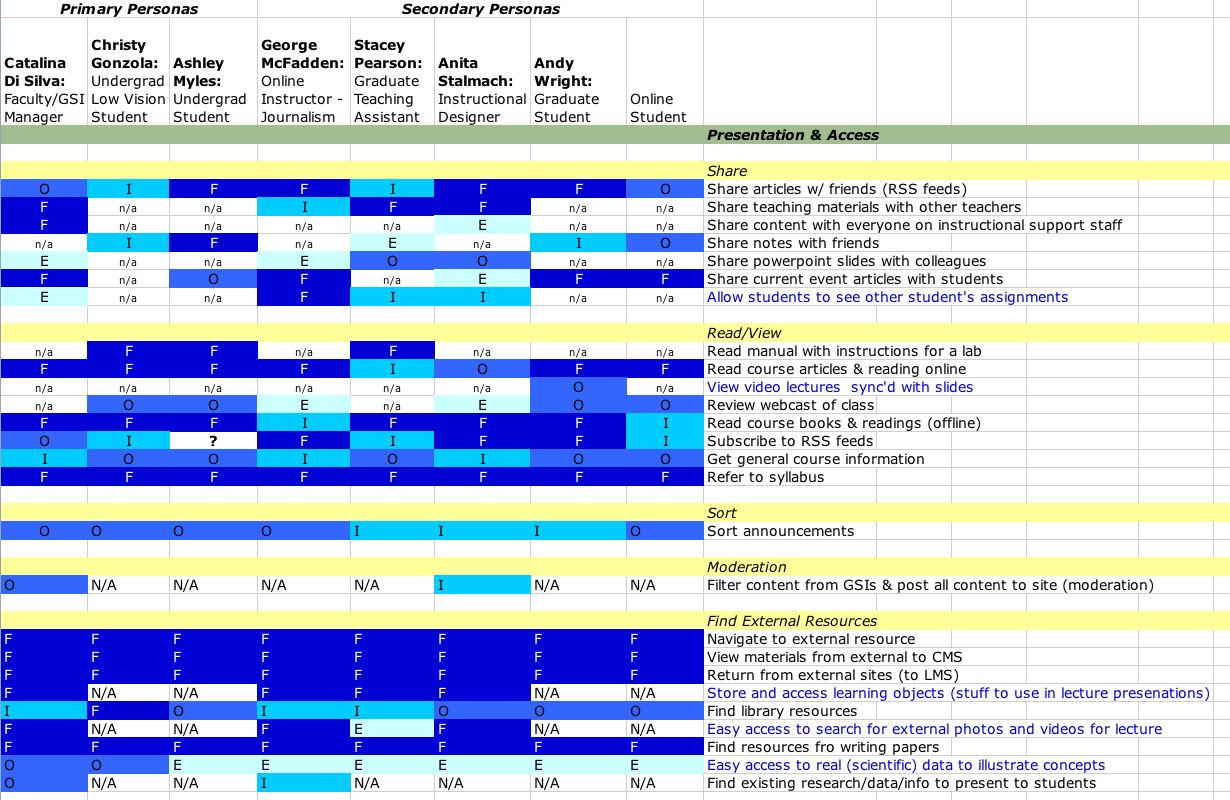This Work is Still In Progress
These models are still a work in progress, and are actively being worked on. While discussion and comments are welcome, please treat this material as such.
User and behaviorial models are a great way to make sense of a lot of user research data.
There are a variety of models we can use to help us in our understanding of our findings and share out our learning with the community. We are focusing on Personas to model users and Use Cases (.ppt) to model behaviorial goals, needs and wants.
Personas
Persona Scales were used to identify and describe personas. We identified 6 Faculty, 4 Student and 2 Instructional staff personas based on 20 Contextual Inquiries with users in these roles (across UC Berkeley, York University & University of Toronto). Our research is an iterative process. We were unable to meet with System Administrators and Institutional Staff in this iteration although we recognize them as an important user group.
The next step was to create rough draft personas based on the persona scales. The personas created at that time have evolved to become the Fluid Personas for Course Administration & Content Management.
For privacy, contextual Inquiry participant initials are used to identify the people on whom each persona was based. Multiple initials mean several participants have been rolled up into the same persona (because they have similar goals, needs & characteristics). The personas describe these archetypes, including their characteristics, goals and distinctions from one another.
Faculty
- Catalina De Silva (Faculty - GSI Manager in Spanish)- Catalina.pdf
- Robin McCoy (Faculty - Business School)
- Ahmad Yousef (Faculty - Tenure-track History)
- Sergio Rossi (Graduate Teaching Assistant - Urban Affairs & Planning)
- Stacey Pearson (Graduate Teaching Assistant - Microbiology)
- Henry Sibley (Longtime Faculty - Math, Provisional Persona)
- George McFadden (Online Instructor - Journalism)
Student
- Christy Gonzola (Undergraduate Student - Molecular & Cell Biology)
- Andy Wright (Graduate Student - Information Studies)
- Ashley Myles (Undergraduate Student - Archeology)
- Shaina Wiseman (Graduate Student - Land Development, Provisional Persona)
Instructional Support Staff
- Michael Demsky (Departmental Support - Biology)
- Anita Stalmach (Departmental Pedagogy Support - Instructional Designer)
Use Cases
"A sequence of actions that takes place in a problem domain between a user and the system."
- Menlo Institute
A variety of models are being worked on with use cases as the focus. They will inform the Fluid component roadmap along with each component's functional requirements.
Affinity Diagramming
Use Case Frequency Matrix
The Frequency Matrix allows us to understand who's doing what and how often.
Completed Use Case Frequency Matrix
Samples from matrix:
|width=300 pixels
Component Identification
Components identified through the research and modeling activities...
Coming soon!
Use Case Priority Matrices
Our priority matrices will help us understand frequency and importance of use cases. Priority matrices can be used to visualize of priority attributes like technical difficulty, design and development effort and even relationships.
We will create a priority matrix for each component on the Fluid Roadmap. Here's what one might look like (borrowed from a previous Sakai project):
|width=300pixels
This matrix was created for the Sakai project. Colors indicate the functional area of the use case. Low-low is the bottom left corner. As you move up Y axis or over on the X axis the measurement gets higher.

